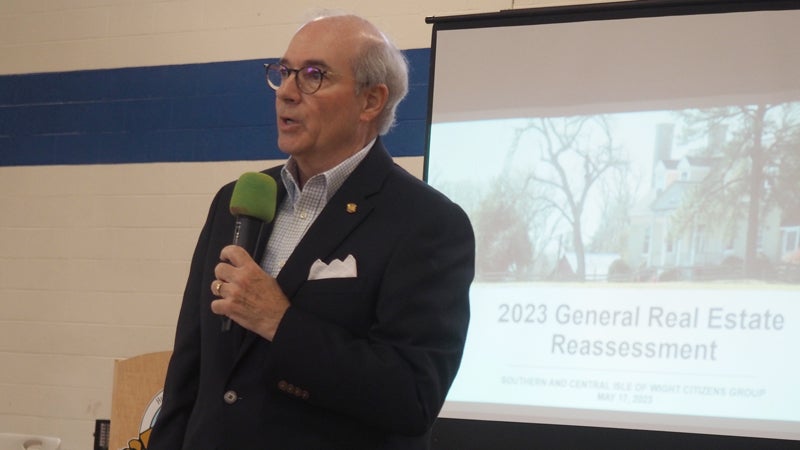Isle of Wight homeowners balk at high reassessments
Published 1:59 pm Friday, May 19, 2023

- Commissioner of the Revenue Gerald Gwaltney speaks to residents at a May 17 meeting of the Southern and Central Isle of Wight Citizens Group at the Windsor Town Center regarding the reassessment process and options for appeal. (May 17 file photo by Stephen Faleski | The Smithfield Times)
When former Isle of Wight County Supervisor Al Casteen received his reassessment notice in the mail last week, he was shocked to see his circa-1954, roughly 3,500-square-foot ranch home in Smithfield is now valued at $770,000 – a 55% increase from when it was last assessed in 2019.
Under the 2023 valuation, Casteen can expect to pay roughly $1,200 more in real estate tax, even if the county follows through with current plans to lower its tax rate.
“This is absurd,” Casteen said.
State law requires counties reassess real estate values every four years. According to Gerald Gwaltney, Isle of Wight County’s commissioner of the revenue, residential, commercial, agricultural and industrial property values in Isle of Wight have collectively increased 28% on average since 2019. Single-family homes went up 34%.
Apartments and other multifamily housing, which are valued based on monthly rent, went up 26%.
Casteen isn’t the only homeowner experiencing sticker shock.
Organizers of a May 17 citizens group forum with Gwaltney had asked attendees to sign in and note the percentage their homes had increased. One person, from Smithfield, noted his home went up 105%. Another, from the town of Windsor, listed 51%.
Susan Craig, who purchased her three-bedroom Zuni home of just under 2,800 square feet in 2021, said her valuation rose 44%. Frank White, another Zuni resident, said his was more in line with the average, at 35.3%.
How were the assessments calculated?
According to Gwaltney, the reassessment process begins a year in advance, in this case 2022, with the county soliciting bids and choosing a third-party appraiser to perform the reassessment. For the past seven reassessments, going back to 2002, the county has awarded the job to Daleville-based Wampler Eanes. Wampler, Gwaltney said, is one of only four firms in the state certified by the Virginia Department of Taxation to perform a “mass appraisal” of the county’s roughly 21,000 individual lots.
In mass appraisals, he explained, assessors don’t look at each individual home to decide its value, but rather the recent sales that have occurred in 181 defined “neighborhoods” within the county. The Gatling Pointe development just outside Smithfield, for example, is divided by Battery Park Road into Gatling Pointe North and Gatling Pointe South. Gatling Pointe North’s homes are older than the ones in Gatling Pointe South, and include waterfront properties. As such, the two halves of the same development are considered different neighborhoods for assessment purposes.
Though according to census data, the number of housing units in Isle of Wight increased 12.4% from 2010 to 2020, compared to the state’s 7.6% housing growth rate, the number of available homes on the market statewide has fallen significantly over the past four years, Gwaltney said.
In 2019, there were over 30,000 homes on the market across Virginia. As of late 2022, there were fewer than 8,000. Last month, there were only 108 homes on the market countywide when assessors completed their work.
“Supply and demand drives so much,” Gwaltney said.
The cost of construction materials, which has surged since 2020 when COVID-19 pandemic-linked supply chain issues emerged, is another factor. When builders are using more expensive materials, they need to sell homes for a higher price to meet their profit margins.
“Those sales are going to drive the value of your property,” Gwaltney said.
Should prospective buyers get into a bidding war over a home on the market, a sale above asking price will drive reassessment valuations even higher.
According to land transfers recorded last month at the Isle of Wight County Courthouse, and county data, 69% of the 49 homes sold in April went for above their 2023 assessed value. Just over 18% of the sale prices exceeded their assessments by 10% or higher.
Craig noted she’d been outbid roughly 20 times on homes in the county before finding her Zuni residence.
“We were being outbid by $50,000 to $60,000 every time,” she said.
While most of the housing growth Isle of Wight has seen over the past decade has been in the county’s northern end, homes in rural areas like Zuni and Carrsville on the county’s southern end saw the largest average increase in residential values, at 42%. The value of agricultural land in the southern end went up 18%, double the 9% increase farmland in the northern end saw.
“People are moving here and they’re willing to pay a little bit more for a piece of God’s country,” Gwaltney said.
According to Jay Hassell, a Smithfield area Realtor, the 2019 valuations have averaged 20% to 25% below market value over the past four years. The 28% average countywide increase among all types of property comes as no surprise to him.
“Even the assessments that increased 40% to 50% or more aren’t all without cause,” Hassell said. “Many of the homeowners I’ve spoken with are quietly happy to see the appreciation, if only it didn’t come with the tax implications. For those residents wanting to sell, the assessment is very welcomed.”
The 2023 values represent what Hassell calls the “near pinnacle” of the market. What’s unknown, Hassell said, is whether the real estate market will remain as hot over the next four years.
Among the factors that drove the market up in 2021 through 2023 was extremely low interest rates, Hassell said. According to Freddie Mac, a government-controlled company that buys residential mortgages to provide money for the U.S. housing market, a borrower could get a 30-year fixed-rate mortgage in mid-2021 at roughly 2.8% interest. As of May 18, that same 30-year mortgage would carry a 6.39% interest rate.
“The question is, as interest rates increase and the home values potentially drop, will taxpayers be paying an inflated assessment over the next four years?” Hassell said.
Is there any relief?
Isle of Wight County supervisors are set to vote in June on the tax rates for the coming 2023-24 fiscal year, which begins July 1. The most recent proposal, as of May 11, calls for lowering the real estate tax rate from 85 cents per $100 of assessed property value to 71 cents. Even with the roughly 19% rate decrease, the county is expecting roughly $3.7 million in additional real estate revenue from the new assessments.
A so-called “revenue-neutral” rate of 66 cents would eliminate the revenue gain and result in the county taking in roughly the same amount of real estate taxes it received for the 2022-23 fiscal year. But even that wouldn’t guarantee every homeowner pays the same amount of taxes as he or she did last year.
Board of Supervisors Chairman William McCarty explained at a recent budget meeting that what’s considered the “neutral” rate, “is not neutral to the taxpayer,” but rather to the cumulative amount of real estate revenue the county would receive.
Each reassessment costs roughly $500,000. The supervisors, Gwaltney noted, have the authority under state law to call for a new reassessment by majority vote if they believe the assessed values to be erroneous. Were the 2023 results to be challenged, the state Department of Taxation would conduct its own sales study.
Such a challenge hasn’t happened in Isle of Wight since the late 1980s. According to a July 26, 1989, edition of The Smithfield Times, state assessors of the day, despite the challenge, found Isle of Wight’s assessment to be within 85% of fair market value.
County residents ages 65 and up, or who are totally disabled, can apply for a credit of up to $1,000 on their real estate tax bills if they have a maximum household income of $54,600 and a maximum net worth, excluding their house and one acre, of $228,596. Applicants must meet both financial criteria to qualify. The supervisors are considering a proposal to increase the amount of relief to $2,000.
Homeowners can also challenge their assessments by using one of three methods.
They have until 5 p.m. on May 26 to request an administrative review, which entails sending a letter, appraisal and photos of their home either by email to IsleofWightreassessment2023@gmail.com to by mail to Isle of Wight County Reassessment Office, P.O. Box 685, Daleville, VA 24083.
Starting July 1 and continuing through June 30, 2024, homeowners can appeal to the county’s Board of Equalization by visiting 17090 Monument Circle, Suite 113, submitting an application in writing to P.O. Box 114, Isle of Wight , VA 23397, faxing an application to 757-356-9731 or emailing reassessment@isleofwightus.net.
The third option available to taxpayers is petitioning the Isle of Wight County Circuit Court for a review. State law allows this option July 1 of this year through June 30, 2027.
In each method, the burden is on the taxpayer to prove that an assessment is erroneous, ideally by researching sales of neighborhood homes of a similar age and size.
As of May 15, 134 county residents had applied for an administrative review, according to Gwaltney. During the 2019 assessment, which saw single-family homes rise in value by a countywide 5% average, roughly 500 residents filed appeals using the three available methods.
Casteen, despite balking at the valuation of his home, isn’t planning on contesting it. He said when he last tried going through the appeal process in the mid-2000s, his valuation ended up getting raised an additional $20,000.
Hassell said his firm, Countryside Real Estate, is offering home evaluation reports at no cost to taxpayers looking to appeal their assessments.
Editor’s note: This story was updated May 19 at 3:50 p.m. with additional information from Smithfield Realtor Jay Hassell.





